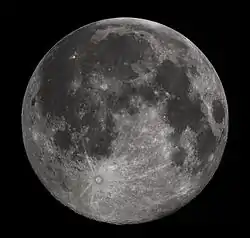Moon rabbit
The moon rabbit or moon hare is a mythical figure who lives on the Moon in Far Eastern folklore, based on pareidolia interpretations that identify the dark markings on the near side of the Moon as a rabbit or hare. The folklore originated in China and then spread to other Asian cultures.[1] In East Asian folklore, the rabbit is seen as pounding with a mortar and pestle, but the contents of the mortar differ among Chinese, Japanese and Korean folklore. In Chinese folklore, the rabbit often is portrayed as a companion of the Moon goddess Chang'e, constantly pounding the elixir of life for her and some show the making of cakes or rice cakes; but in Japanese and Korean versions, the rabbit is pounding the ingredients for mochi or some other type of rice cakes. In some Chinese versions, the rabbit pounds medicine for the mortals and some include making of mooncakes. Unrelated moon folklore from certain native cultures of the Americas also has rabbit themes and characters.
| Moon rabbit | |||||||||||
|---|---|---|---|---|---|---|---|---|---|---|---|
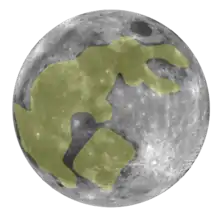 The image of a rabbit and mortar delineated on the Moon's surface | |||||||||||
| Chinese name | |||||||||||
| Chinese | 月兔 | ||||||||||
| Literal meaning | Moon rabbit/hare | ||||||||||
| |||||||||||
| Alternative Chinese name | |||||||||||
| Chinese | 玉兔 | ||||||||||
| Literal meaning | Jade rabbit/hare | ||||||||||
| |||||||||||
| Vietnamese name | |||||||||||
| Vietnamese | Thỏ ngọc | ||||||||||
| Korean name | |||||||||||
| Hangul | 달토끼 | ||||||||||
| |||||||||||
| Japanese name | |||||||||||
| Kanji | 月の兎 | ||||||||||
| |||||||||||
History
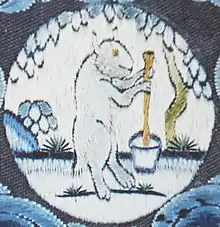
An early Chinese source called the Chu Ci, a Western Han anthology of Chinese poems from the Warring States period, notes that along with a toad, there is a hare on the Moon who constantly pounds herbs for the immortals. This notion is supported by later texts, including the Song-era Taiping Imperial Reader. As rabbits were not yet introduced to China during Western Han, the original image was not a rabbit but a hare.[2]
Han Dynasty poets call the hare on the Moon the "Jade Hare" (玉兔) or the "Gold Hare" (金兔), and these phrases were used often, in place of the word for the Moon. A famous poet of Tang China, Li Bai, relates how "The rabbit in the moon pounds the medicine in vain" in his poem, "The Old Dust".[3]
Asian folklore
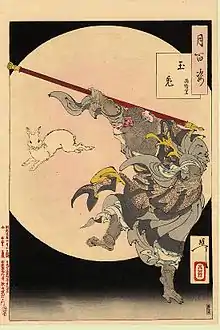
In the Buddhist Jataka tales,[4] Tale 316 relates that a monkey, an otter, a jackal, and a rabbit resolved to practice charity on the day of the full moon (Uposatha), believing a demonstration of great virtue would earn a great reward. When an old man begged for food from them, the monkey gathered fruits from the trees and the otter collected fish, while the jackal found a lizard and a pot of milk-curd. The rabbit, who knew only how to gather grass, instead offered its own body, throwing itself into a fire the man had prepared. The rabbit, was not burnt, however. The old man revealed that he was Śakra, and touched by the rabbit's virtue, drew the likeness of the rabbit on the Moon for all to see. It is said the lunar image is still draped in the smoke that rose when the rabbit cast itself into the fire. The rabbit is believed to be a Bodhisattva.
A version of this story may be found in the Japanese anthology, Konjaku Monogatarishū, where the rabbit's companions are a fox, instead of a jackal, and a monkey.
The moon rabbit legend is popular and part of local folklore throughout Asia. It may be found in diverse cultures in China, Japan, India, Korea, Sri Lanka, Cambodia, Thailand, Vietnam, and Myanmar.[5][6][7]
This legend also gave rise to the Mid-Autumn Festivals of China and Vietnam, Tsukimi of Japan, and Chuseok of Korea, Sampeah Preah Khae in Cambodia, all of which celebrate the legend of the moon rabbit. In Vietnamese mythology, the Jade Rabbit on the Moon is often accompanied by the Moon Lady and Cuội, who sits under a magical banyan. The trio has become the personifications of the holiday, when they descend to the mortal world and give out cellophane lanterns, mooncakes and gifts to children.[8]
Rabbits in indigenous American moon folklore
Presumed to be arising likewise, through lunar pareidolia, legends of moon rabbits also exist among some of the indigenous peoples of the Americas. These legends are not considered to have been influenced by Asian cultures.
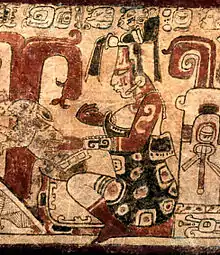
In Mayan art, glyphs, hieroglyphics, and inscriptions, a rabbit frequently is shown with their Moon Goddess and another deity related to the moon.
According to an Aztec legend, the god Quetzalcoatl, then living on Earth as a human, started on a journey and, after walking for a long time, became hungry and tired. With no food or water around, he thought he would die. Then a rabbit grazing nearby offered herself as food to save his life. Quetzalcoatl, moved by the rabbit's noble offering, elevated her to the Moon, then lowered her back to Earth and told her, "You may be just a rabbit, but everyone will remember you; there is your image in light, for all people and for all times."
Another Mesoamerican legend tells of the brave and noble sacrifice of Nanahuatzin during the creation of the fifth sun. Humble Nanahuatzin sacrificed himself in fire to become the new sun, but the wealthy god Tecciztecatl hesitated four times before he finally set himself alight to become the Moon. Due to Tecciztecatl's cowardice, the deities felt that the Moon should not be so bright as the sun, so one of the deities threw a rabbit at his face to diminish his light.[9] Another version of the legend says that Tecciztecatl was in the form of a rabbit when he sacrificed himself to become the Moon, casting his shadow there.
Farther north in America in a region now identified as ranging across Canada and United States, a Cree cultural legend tells a different story, about a young rabbit who wished to ride the Moon. Only the crane was willing to take him there. The trip stretched the crane's legs as the heavy rabbit held them tightly, leaving them elongated as the legs of all cranes are now. When they reached the Moon, the rabbit touched the crane's head with a bleeding paw, leaving the red mark those cranes wear to this day. According to the legend, on clear nights, Rabbit still may be seen riding the Moon.
Modern references
Spaceflight
- The Chinese lunar rover, Yutu, that landed on the Moon on December 14, 2013 was named after the Jade Rabbit, as a result of an online poll,[10] and was followed up by a second rover, Yutu-2 which deployed on the far-side of the Moon on 3 Jan 2019.[11]
- The moon rabbit was the subject of a humorous conversation between NASA mission control and the crew of Apollo 11:[12]
- Houston: Among the large headlines concerning Apollo this morning, is one asking that you watch for a lovely girl with a big rabbit. An ancient legend says a beautiful Chinese girl called Chang-O has been living there for 4,000 years. It seems she was banished to the Moon because she stole the pill of immortality from her husband. You might also look for her companion, a large Chinese rabbit, who is easy to spot since he is always standing on his hind feet in the shade of a cinnamon tree. The name of the rabbit is not reported.
- Michael Collins: Okay. We'll keep a close eye out for the bunny girl.[note 1]
Commerce
The Japanese cosmetics company, Makanai, has a logo that is a moon rabbit pounding gold, representing abundance of harvest, beauty, and longevity.[13] Makanai was established in 1999 as a tribute to the century-old tradition of goldbeaters manually making gold leaves at its predecessor company, Yoshitaka Gold Leaf Foundry. The gold foundry was established in 1899 in Kanazawa.
Education
Waso Learn, Myanmar educational mobile application that develops for the purpose of teaching and learning starting from primary to high school level, has a logo of the moon and a rabbit wearing Myanmar school uniform.[14] It became well-known during COVID-19 pandemic in Myanmar. It seems like the name, 'Waso' is taken from full moon of Waso which means Dhammacakka.
Comics and animation
- The eponymous Sailor Moon's human name is Usagi Tsukino, a pun on 月のうさぎ (Rom. Tsuki no usagi), which means Moon Rabbit in Japanese. Her daughter's name, Chibiusa, means little rabbit.
- The 1998–1999 Japanese-exclusive Transformers animated series, Beast Wars II, features Moon, a robotic rabbit who lives in the Moon with Artemis.
- The moon rabbit theme makes an appearance in the "Legend of the Stars" section of the Kamen Rider Spirits manga, told by Sergei Koribanof to his son Masim.
- In the Dragon Ball animation, Son Goku fights against the Rabbit Gang and solves the issue presented in the episode by taking the enemy leader, an anthropomorphic rabbit, and his human companions, to the Moon, where they are seen pounding rice cake mixture.
- The overarching plot in Naruto ends in a finale where the main characters fight against Kaguya Ōtsutsuki, who is consumed by her powers and sealed by her children to become what would eventually be known as the Moon.
- The song ‘have a dream’ from Aikatsu Friends! has a reference in the final chorus, it talks of the Moon rabbit said to pound mochi using a mortar and pestle. “That rabbit continues pounding mochi, even today on the night of the full moon, we feast”
- In the Is It Wrong to Try to Pick Up Girls in a Dungeon? anime, the character Cassandra Illion during the War Games between the Apollo and Hestia Familias talks of a dream she had of a white rabbit jumping over the Moon and eating the Sun.
- In the Batman Confidential storyline "Lovers and Madmen", the newly transformed Joker goes insane after realizing there's "A bunny in the moon".
- In the Problem Children Are Coming from Another World, Aren't They? anime, the character Black Rabbit is a Moon rabbit, with several references to the legends.
- In the movie Over the Moon, there is a rabbit called 'Jade' and he the companion of the goddess Chang'e. The rabbit is also green like jade.
- In the manga Thus Spoke Kishibe Rohan - Episode 4: The Harvest Moon a supernatural creature by the name of The Moon Rabbit (月の兎 Tsuki no Usagi) is responsible for the curse of the Mochizuki family.
Literature
- In a scene in the sixteenth century Chinese novel, Journey to the West, Sun Wukong fights the Moon Rabbit.
- Douglas Wood wrote Rabbit and the Moon, an adaption of the Cree legend in 1998.
Live-action television
- The Super Beast Lunatyx is a kaiju, a character based on the Moon Rabbit. He appears in the Tokusatsu series, Ultraman Ace. His connection to the Moon Rabbit is further highlighted when it is revealed that he was responsible for draining the Moon of its magma (which was also the home of one of Ace's co-hosts, Yuko Minami), transforming it into a barren wasteland.
Music

- The American electronic music act, Rabbit in the Moon, founded in 1991, gets its name from this legend.
- The German band, Tarwater, released the albums Rabbit Moon and Rabbit Moon Revisited.
- The American emo act, Jets to Brazil, has a song "Perfecting Loneliness" that features the Apollo recording discussing the legend.
- The K-Pop boys band, BTS, referenced the legend in their song and music video IDOL. In the song, the boys thank their haters for always talking about them, alluding to the saying "if you get cursed a lot, you will live longer" (욕을 많이 먹으면 오래산다) and intertwining it with the moon rabbit legend, who is thought to craft the beverage for immortality; so thanks to all the hate they receive, they will live forever. When the image of the rabbit on the Moon appears in the video, the members can even be heard chanting "tokki" (토끼) in the background, which sounds a lot like the English word "talking" yet means "rabbit" in Korean.
- The Italian band, Moonlight Haze, has a song "The Rabbit of the Moon", which is inspired by the ancient Japanese legend.
Stage
- The rabbit in the Moon is a major theme in the 2011 musical, South Street,[15] with the rabbit appearing prominently in the Moon clock in Sammy's bar, and the main character being advised to "Look to the rabbit" for inspiration.
Video games
Many video games have major characters based on the tale, including Reisen Udongein Inaba from Touhou Project, the Broodals from Super Mario Odyssey, and Chang'e and the Jade Rabbit/Moon Rabbit are featured as playable characters in the video game Smite.[16]
The Jade Rabbit is the name of a scout rifle in the Destiny series of games. In Destiny 2, players can visit the Moon and find miniature statues of chibi-styled jade rabbit dolls which accept offerings of rice cake.[17]
In Final Fantasy IV the player can encounter the Hummingway, a rabbit-like race that lives on the moon
See also
Notes
- NASA transcripts had attributed the response to Aldrin (Apollo 11 Technical Air-to-Ground Voice Transcription. National Aeronautics and Space Administration. Page 179), but corrected NASA transcripts attribute it to Collins.[12]
References
- Windling, Terri. The Symbolism of Rabbits and Hares. Archived 2012-04-24 at WebCite
- "月兔的兔,是什么兔?". 果壳 科技有意思 (in Chinese). 2013-12-03. Retrieved 2019-08-21.
- "The Old Dust Poem by Li Po - Poem Hunter". PoemHunter.com. Retrieved 2019-08-21.
- Source: (accessed: Saturday January 23, 2010)
- http://www.exoticindiaart.com/book/details/jatakas-birth-stories-of-bodhisatta-IDH502/
- Wickremeratne, Swarna (February 2012). Buddha in Sri Lanka: Remembered Yesterdays. ISBN 9780791481141.
- Abbott, Gerry (2000). The Folk-Tales of Burma: An Introduction. ISBN 9004118128.
- Fairy Tale of Moon Lady in Vietnam
- Smith, Michael (2012). The Aztecs (3rd ed.). Chichester, West Sussex ; Malden, MA: John Wiley & Sons. p. 200. ISBN 978-1-4051-9497-6.
- Ramzy, Austin. "China to Send 'Jade Rabbit' Rover to the Moon". nytimes.com.
- Rivers, Matt (January 3, 2019). "China lunar rover successfully touches down on far side of the moon, state media announces". CNN. Retrieved January 3, 2019.
- Woods, W. David; MacTaggart, Kenneth D.; O'Brien, Frank. "Day 5: Preparations for Landing". The Apollo 11 Flight Journal. National Aeronautics and Space Administration. Retrieved 9 October 2017
- http://en.makanaicosmetics.co.jp/about/index
- Waso Learn
- "Theater review: 'South Street' at the Pasadena Playhouse". LA Times. 2011-09-28. Retrieved 2012-07-28.
- Chang'e dances into Smite, brings Jade Rabbit with her. Archived 2013-07-26 at the Wayback Machine
- "the jade rabbit moon destiny 2 - Google Search". www.google.com. Retrieved 2020-12-07.
External links
| Wikimedia Commons has media related to Moon Rabbit. |
- Kazumaro, Kanbe. "Buddhist sayings in everyday life – Tsuki no Usagi". Otani University. 2005. Retrieved on July 25, 2007.(in Japanese)
- Varma. C.B. "The Hare on the Moon". The Illustrated Jataka & Other Stories of the Buddha. 2002. Retrieved on July 25, 2007.
- 「與月為伴 愉閱中秋」, Taipei Public Library. 2006. Retrieved on July 25, 2007. (in Chinese)
- Wood, Douglas – "Rabbit and the Moon"
